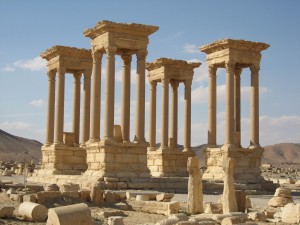Lessons from Palmyra: Is history still in danger, or can we worry about today?
By Elayne Stecher
It was only January 2014 that American president Barack Obama referred to the Islamic State, then a recognized affiliate of Al Qaeda, as a “jayvee team” compared to its parent organization. By January 2015, the Islamic State cut ties with Al Qaeda, declared a caliphate, exercised de facto control over “an area larger than the United Kingdom,” and began a campaign of widely-publicized acts of violence against humanity and history.

Some of this violence was directed toward one of Syria’s most historic sites. The New York Times recently published a series of photographs depicting the damage wrought to the ancient Semitic city of Palmyra, Syria, after ten months of occupation by the Islamic State. Many of the site’s archaeological treasures, including several temples and works dating back to the Persian and Roman empires, were damaged or destroyed. Some sites are still intact, including the ancient Roman amphitheater, which was used as a backdrop for the videotaped execution of 25 Syrian soldiers in July 2015.
In early April of this year, Al Jazeera reported the discovery of a mass grave among the Roman ruins. It seems that when the Islamic State isn’t busy destroying history, it is re-writing it, adding new, gruesome significance to cultural heritage sites.
Palmyra, which was officially recaptured by Syrian troops with Russian assistance on March 27, 2016, has been a UNESCO World Heritage Site since 1980, was one of the six World Heritage sites in the Syrian Arab Republic placed on the list of World Heritage in Danger as of 2013, in response to the “civil strife and turmoil” in Syria. The Syrian Civil War and its spillover effects were strong impetus for movements to protect the cultural heritage of the Levant and Turkey. The 38th session of the World Heritage Committee convened in June 2014 in Doha, Qatar to add new locations—including the Erbil Citadel in Iraq and two sites in Turkey— to the list of World Heritage Sites.
In June 2015, the UN General Assembly unanimously adopted a resolution to save the cultural heritage of Iraq, with UNESCO Director-General Irina Bokova stating that, “the deliberate destruction of cultural heritage is a war crime.” This resolution was partially a response to the Islamic State’s campaigns in Nimrud, Nineveh and Hatra, which garnered massive international attention and fueled the Islamic State’s well-organized propaganda apparatus.
By targeting sites such as St. Elijah’s Monetary, a Christian heritage site, and the tombs of a Shiite saint and Sufi scholar, the Islamic State frames the destruction it propagates as necessary for an “unadulterated caliphate” that rejects idolatry and sacrilegious imagery. However, the true intent behind the destruction of these cultural legacies seems less to do with Wahhabism than pragmatism: the international outcry that follows this sort of destruction increases the social media clout of the Islamic State.
Targeting historic sites (as well as other, over-the-top displays of violence) is in keeping with IS leader Abu Musab al-Zarqawi’s strategy of using “video clips of violent martyrdom missions, glossy computer-generated imagery, and gruesome execution videos… to reach his audience, deliver his ideological message, and garner massive support.” Yet, the biggest challenge to this strategy is the constant need for intensification: “violence has to be steady and escalatory to continue to shock and deter. Random acts of violence are not enough in this context. Brutality has to be ever more savage, creative and shocking.”
Smuggling antiques may be more profitable than blowing them up, especially as the shock-and-awe value of this type of violence loses its novelty and the landscape of conflict changes. While the Islamic State continues to lose ground in Syria and Iraq—over 14 percent of its territorial holdings in the past year—it seems likely that the tactic of destroying historical sites will continue to be eclipsed by a newer, flashier form of devastation. The most terrible examples, like what occurred in Turkey, Egypt, Paris, California and Brussels, are demonstrative of the Islamic State’s increasing focus on “far enemy centric terrorism,” and the culmination of a paradigm shift in the organization’s strategy.
It seems like history, then, may no longer be facing an existential threat from Islamic State. While the international community works to restore and protect the cultural legacy of the Levant, it may be worthwhile to remember that our humanity should extend as much to the people as the places affected by this violence. After all, is there a point that an entire generation of children displaced also constitutes “World Heritage in Danger”?
Elayne Stecher is an A14 alumna of Tufts University with a BA in Arabic and International Relations and is currently an employee of the Center for International Environment and Resource Policy at the Fletcher School.
